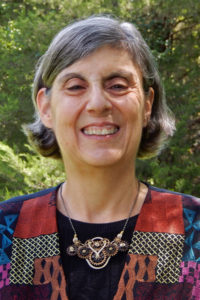 This month’s author interview is with award-winning children’s book author, Laurie Wallmark, who writes wonderful picture books and regularly presents at conferences. She also offers webinars on kidlit writing, too, like the one I attended last week from her at The Writing Barn!
This month’s author interview is with award-winning children’s book author, Laurie Wallmark, who writes wonderful picture books and regularly presents at conferences. She also offers webinars on kidlit writing, too, like the one I attended last week from her at The Writing Barn!
Here are five more things you should know about Laurie. She:
- has two grown daughters (both software engineers!)
- co-chairs the Rutgers University Council on Children’s Literature
- taught computer science to students incarcerated in maximum security prisons
- has had four separate careers–software engineer, owner of a mail-order company selling books about adoption and infertility, computer science professor, children’s book author
- had a bookstore on the web before Amazon did
Now that we’ve got a much clearer sense of the background basics, let’s get to the actual interview and find out more about Laurie’s secret to PB success.
RVC: So, we know each other through Jane Yolen’s Picture Book Boot Camp. How did you get involved with that?
LW: As soon as I saw the announcement that Jane Yolen and Heidi Stemple were holding a picture book boot camp, I was immediately interested. After speaking with a friend who had attended before, I knew I had to apply.
RVC: What has Jane’s support and guidance meant to you?
LW: The kidlit author community has always been a warm and supportive community. But to have someone with as much experience in the field as Jane in my corner means the world to me. Whether it’s sharing publishing business information or giving a “you can do it” just when you need it, I know I can count on Jane.
RVC: How’d you get started in writing children’s books? Since you had a career in software engineering and computer science, I’m guessing the writing bug came later.
LW: The writing bug came significantly later. As a child, the only creative writing I did was a few poems and some songs. About 20 years ago, I had an idea for a middle-grade novel, so I read many craft books and took writing workshops. That book didn’t sell, so I figured I wasn’t a writer. Five years later, I had another idea for a middle-grade novel. This one did sell, but the publishing company went out of business. But by this time, I was hooked. Later, I took one more writing break when it felt like I was also so close to getting published, but never quite getting across the finishing line.
Luckily, I couldn’t stay away from writing.
RVC: Why did you choose to earn an MFA in Writing?
LW: After that second break, I decided I needed to concentrate on improving my craft rather than think about getting published. An MFA would help me to do just that.
RVC: What are some of the specific ways the MFA in Writing for Children & Young Adults at Vermont College of Fine Arts helped prepare you for success as a picture book writer?
LW: My first semester at VCFA, I took a picture book intensive. Having to write so many different types of picture books in so little time forced me to figure out how to get to the heart of the story and write it.
RVC: Unlike some writers who try their hand at everything, you’re laser focused—you write picture book biographies about women in STEM areas. Why is that your calling?
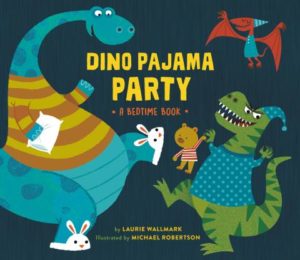 LW: I write about women in STEM because I love science and math, and I want to make sure that all children realize that anyone can join the field. But, I also have a fiction picture book, Dino Pajama Party, coming out in October from Running Press Kids. What’s funny is that because of my reputation, people ask me if it’s nonfiction.
LW: I write about women in STEM because I love science and math, and I want to make sure that all children realize that anyone can join the field. But, I also have a fiction picture book, Dino Pajama Party, coming out in October from Running Press Kids. What’s funny is that because of my reputation, people ask me if it’s nonfiction.
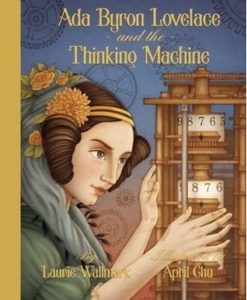 RVC: Here’s hoping the cover helps clue them in!
RVC: Here’s hoping the cover helps clue them in!
Now, your first book was Ada Byron Lovelace and the Thinking Machine (Creston Books 2015). What’s the story of how that came about?
LW: I’ve always loved math, and I wanted to share that love with kids. Since I’m a computer scientist, and Ada is a mathematician and the world’s first computer programmer, she seemed like the perfect subject for a biography.
RVC: Let’s talk about the process of writing your books. How do you get your ideas? Do you start with a subject, a person, or something else?
LW: For my women in STEM books, I keep a running list of people I might want to write about. When the time comes, I review that list and any notes I’ve already made, like the availability of source material.
For my fiction, I also keep a running list, but in this case it might be an idea, a title, a phrase, or a character. Again, periodically I review the list to see if any would make a good picture book.
RVC: How much research do you do before actually writing?
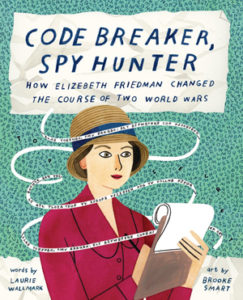 LW: I do almost all my research before I start writing. Invariably I come across discrepancies in the information, and that’s when you need to dig deeper. That’s where archive librarians are really helpful. As a simple example, in my new book, Code Breaker, Spy Hunter, the illustrator wanted to draw a picture of Elizebeth Friedman with her grandchildren. I knew she had had six, but what were their sexes and relative ages? Librarians to the rescue.
LW: I do almost all my research before I start writing. Invariably I come across discrepancies in the information, and that’s when you need to dig deeper. That’s where archive librarians are really helpful. As a simple example, in my new book, Code Breaker, Spy Hunter, the illustrator wanted to draw a picture of Elizebeth Friedman with her grandchildren. I knew she had had six, but what were their sexes and relative ages? Librarians to the rescue.
RVC: That book’s coming out this month. Congrats on that! How’d you get hooked on her story?
LW: What’s fascinating to me about Elizebeth is that she wasn’t interested in math or science as a kid. She loved languages and majored in English. Yet she went on to be one of America’s most important cryptologists, helping to capture Nazi spies and rum runners. She also created the CIA’s first cryptology department.
RVC: She sounds positively awesome. I look forward to reading the book.
But part of the challenge with writing picture book biographies is making them interesting. What are some of the strategies you use to make that happen?
LW: I think if the author has a passion for what the subject’s field, it comes through in the writing. In my case, I love science and math, as you may have figured out by now!
RVC: Back matter. How do you know if you should use it? And if so, what and how much?
LW: You need to have, at the very least, a timeline of the person’s life and selected resources. Teachers and librarians appreciate the back matter, so it’s worthwhile for authors to include more. My back matter usually includes a more detailed explanation of the scientific or mathematical principles in the book. But in addition, I’ve included more unusual back matter such as transliterating from the Cyrillic alphabet and the subject’s various nicknames.
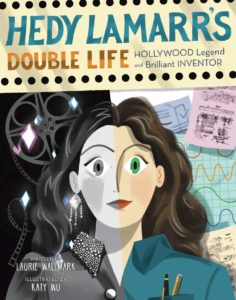 RVC: If someone’s already covered the person you want to write about, should authors just move on? I’m thinking about the situation with your book Hedy Lamarr’s Double Life and Jan Wahl’s Hedy & her Amazing Invention.
RVC: If someone’s already covered the person you want to write about, should authors just move on? I’m thinking about the situation with your book Hedy Lamarr’s Double Life and Jan Wahl’s Hedy & her Amazing Invention.
LW: A better example is Ada Lovelace. After my book came out, three more picture books about her also came out within a year.
I’d say if you know ahead of time, you should consider writing about another person. But if the subject is important to you, go for it. Clearly we need more than one book about any specific person.
RVC: Part of what sells books is giving a great author visit to libraries and schools. What kind of activities does the Friedman story lend itself to when you’re promoting that new book?
LW: This one’s easy, because the kids can have fun learning how to code and decode messages. Maybe I can find a Dick Tracy magic decoder ring.
RVC: I’ll take one, if you have those!
One last question for this part of the interview. Cuts happen, and good things sometimes don’t make it into the pages—it’s a fact of publishing. So, what didn’t make it into Code Breaker, Spy Hunter?
LW: Elizebeth worked on so many cases that it was hard to decide which ones to leave out. Even though I had 48 pages, which is a lot for a picture book, I could only include her most famous ones. For example, she was once called in to settle a dispute between two countries by showing a sailing vessel flying a Canadian flag was actually a US ship.
RVC: Alright, Laurie—it’s time for the LIGHTNING ROUND! Zippy questions, zappy answers, please. Are you ready?
LW: Go for it.
RVC: What’s your biggest time waster?
LW: Reading.
RVC: Favorite literary villain?
LW: Professor Moriarty.
RVC: Which of the STEM women you’ve written about would you most like to hang out with?
LW: Elizebeth Friedman. We could talk about both math (cryptology) and literature.
RVC: Five words that describe your writing process.
LW: Slow. Slow. Slow. Slow. Lightning-speed.
RVC: What’s a recent women-in-STEM biography that really got your attention?
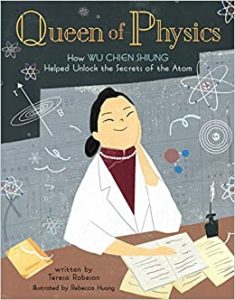 LW: Teresa Robeson’s Queen of Physics: How Wu Chien Shiun Helped Unlock the Secrets of the Atom.
LW: Teresa Robeson’s Queen of Physics: How Wu Chien Shiun Helped Unlock the Secrets of the Atom.
RVC: What’s the best book compliment a kid every gave you?
LW: One of my school visit presentations is about women in computing. During a Q&A, one student said, “Ms. Wallmark, you should write a book about you.”
RVC: Thanks so much, Laurie! Best of luck with Code Breaker, Spy Hunter, too!


I always love reading more about Laurie because I think she’s brilliant and I want to know how she works. And here, too, I have to thank her for the Queen of Physics shout-out!
So glad when authors and illustrators see shout-outs at OPB. Thanks for stopping by, Teresa!
What a wonderful interview! Thank you.
In every encounter with Laurie, in interviews, workshop, or webinars, and even in the author notes in back matter or on her website, she consistently brings something new and helpful to those who love reading and writing and amazing books!
Totally agree. Laurie is quite good at what she does with PB biographies!